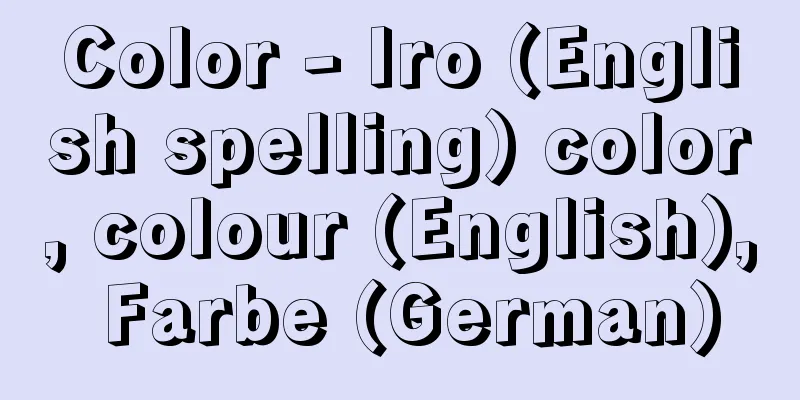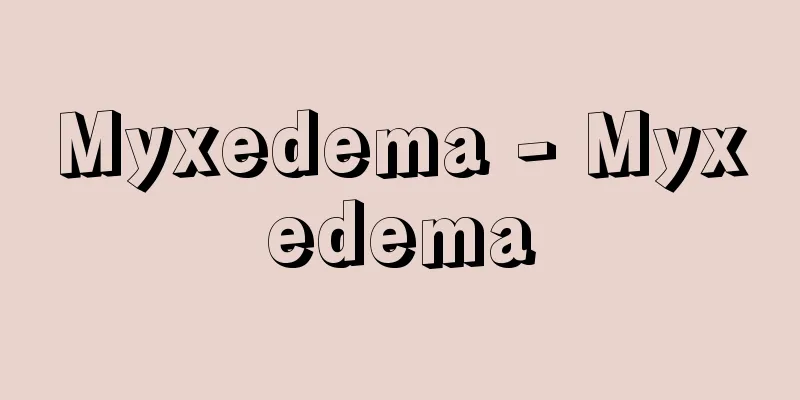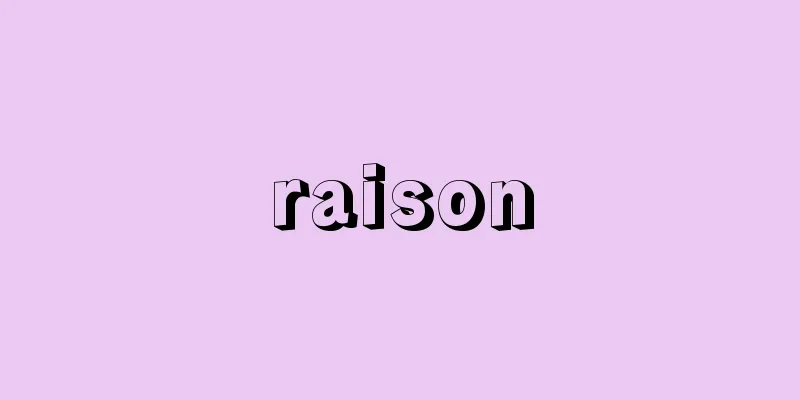Color - Iro (English spelling) color, colour (English), Farbe (German)

|
Color is not an attribute of an object or light. Color is a type of sensation, and the sensation of color (color vision) arises as a result of the light that reaches the eye being processed by the eye and brain. The color we perceive for light or an object is determined not only by the type of light that reaches the eye when we observe it, but also by how it is processed by the visual system. Of these, the characteristics of the light that reaches the eye are determined by the spectral intensity distribution of the light when it is observed directly, and by the spectral intensity distribution of the illumination light that illuminates the object and the spectral reflectance of the object's surface when observing an object (Figure 1 on page 20). [Color Basics] Humans perceive light as electromagnetic waves with wavelengths of approximately 380 to 760 nm (Figure 2 on page 20), and when we extract light of a specific wavelength, it appears colored. Light that contains only a very narrow range of wavelengths is called monochromatic light, or spectral light. The color of monochromatic light changes according to the wavelength, and from short wavelengths to long wavelengths, it follows a continuous change from violet → blue → blue-green → green → yellow-green → yellow → orange → red. Short-wavelength light that appears blue and long-wavelength light that appears red differ only in the wavelength of light, but the perceived colors are qualitatively different, such as blue and red. This clearly shows that color is a sensation, not an attribute of light. Since the wavelength and color of light correspond to a certain extent, the color we perceive for a certain light changes depending on the amount of each wavelength light contained in it. The intensity of light as a function of wavelength is called the spectral power distribution, or spectral energy distribution, and this can be used to describe the characteristics of light related to color. For example, the lighting light (incandescent light) shown in Figure 1(a) has strong energy in the long-wavelength region and produces orange-colored light. When light from a light source hits an object, some of it is reflected. Spectral reflectance indicates the degree to which light of each wavelength is reflected. This spectral reflectance is the main physical factor that determines the color of an object surface. If the spectral intensity distribution of the light source is E(λ) and the spectral reflectance of the object surface is R(λ) , the spectral intensity distribution I(λ) of the light reflected from the object can be calculated by the product of the two (see Figure 1, where λ represents the wavelength). I(λ)=E(λ)・R(λ) Figure 1(b) shows the spectral reflectance of a bell pepper. Because it strongly reflects mid-wavelength light, which appears green, the mid-wavelength light is relatively strong in the spectral intensity distribution of the reflected light. Colors appear in various ways, such as the green of bell peppers, which appear as if they are attached to the surface of an object, or the blue of the sky, which appears as if it is unclear where the color is located. These differences in color appearance are called differences in the mode of color appearance. Various classifications have been made up to now, but a simple classification is divided into object color mode and light source color mode. The object color mode refers to the appearance of a color when the color appears to be attached to the surface of an object, as in the example of bell peppers, and is perceived as an attribute of the object surface. In contrast, the light source color mode refers to the appearance of a color when it is perceived as emitting light itself. The mode of color appearance is usually determined by whether the object actually emits or reflects light, but it can also be determined by the observation conditions rather than physical conditions. For example, even if a colored piece of paper actually reflects light, if it is placed alone in the dark, it will be perceived as emitting light in the light source color mode. Conversely, even if it actually emits light, such as a color television screen, it will appear as object color mode if there are objects of various brightness and colors around it. Depending on the mode of color appearance, attributes such as the spread of color and the clarity of its localization change, but the perceived color itself also changes. For example, brown, gold, and silver are colors specific to the object color mode and are not perceived in the light-source color mode. The color of light is made up of three attributes: hue, brightness, and saturation. Hue refers to a shade of color, such as blue or red, and brightness indicates how bright the color is. Saturation (also called saturation) indicates how vivid the color is. For example, the difference between red, pink, and white is the difference in saturation. White, gray, and black, which contain no hue, have a saturation of zero and are called achromatic colors. All other colors are called chromatic colors. The three attributes of object color relative to the color of light are hue, lightness, and saturation. It is difficult to distinguish between brightness and lightness, but strictly speaking, brightness is the perceived intensity of light and is expressed as bright or dark, while lightness is the apparent reflectance of the surface of an object and is expressed as white or black. The three attributes of color are represented in a three-dimensional space (color solid) as shown in Figure 3. Hue can be described as a series of closed circular progressions, adding purple to the hues within the visible range: violet (blue-purple) → blue → blue-green → green → yellow-green → yellow → orange → red → red-purple → purple → violet... A circular representation of the change in hue is called a hue circle. In a color solid, an achromatic color is placed at the center of the hue circle, and saturation is represented by how far the color is from that center. Brightness and lightness are represented by changes in the direction perpendicular to the hue circle. [Theory of color vision] Traditional color vision theories that explain how color stimuli are processed by the visual system include the trichromatic theory and the opponent color theory. The trichromatic theory is a theory of color vision that explains the sensation of color through a combination of responses from three types of photoreceptors. It was proposed by T. Young in the early 19th century, and developed and systematized by Helmholtz, H.L. Fon in the late 19th century. The trichromatic theory is based on color matching experiments using additive color mixture. Additive color mixture refers to the process of adding multiple lights together, and the light to be added is called the primary stimulus. By adjusting the ratio of each primary stimulus in additive color mixture, it is possible to make the color of the light appear to be equal to that of another light (test light). This process is called color matching. In this case, the spectral intensity distributions of the mixed light and the test light are physically different, but they are indistinguishable from each other. This type of color matching is called metameric color match. Color matching experiments have shown that if there are three mutually independent primary stimuli, they can be matched to any light by additive mixing, and this is called trichromacy of color vision. "Independent of each other" means that the mixture of the two primary stimuli makes them unable to become color-matched to the remaining one. According to the trichromatic theory, colored light causes three types of photoreceptors to respond at a certain rate, and the colors of the colored light are distinguished by the difference in the response rate. Therefore, even if the light is physically different, it cannot be distinguished if the response produced by the photoreceptors is equal. This is why metamerism occurs. The opponent-color theory is a theory of color vision proposed by Hering, E. in the late 19th century. If red light is mixed with green light, red-green is not perceived, and red and green cancel each other out. From this observation that red and green, and yellow and blue do not coexist, Hering gained insight into the mechanism behind it. According to the opponent-color theory, the visual system has two types of color processing processes, the red-green process and the yellow-blue process, which show antagonistic responses depending on the wavelength of light. If the difference in polarity is expressed as positive and negative, a positive response generated by the red-green process corresponds to the sensation of red, and a negative response corresponds to the sensation of green (the combination of positive and negative responses and colors is arbitrary). The same is true for the yellow-blue process. Since a specific light produces either a positive or negative response, red and green, or yellow and blue, are not perceived at the same time. The sensation of color is explained by the combination of the responses of the red-green process and the yellow-blue process. In addition, a black-white process that mediates the sensation of brightness is also hypothesized. By assuming this opponent color process, it is possible to explain why, in chromatic adaptation, when we adapt to a certain colored light, our sensitivity to its opponent (complementary) color increases relatively; why a color afterimage (temporal contrast) becomes the opponent color of the stimulus color; and why, in color contrast phenomena (phenomenon in which a color is induced in a direction that emphasizes its difference from its surroundings), the induced color becomes the opponent color. The trichromatic theory and the opponent color theory were originally competing theories, but subsequent research has provided evidence of the validity of each theory, and they are now integrated into the stage theory. The stage theory of color vision is a theory that explains color vision through hierarchical processing, and all current color vision models take this position. Figure 4 shows an overview of the stage theory. The first stage of processing color stimuli is the cone process that receives light, and trichromatic processing takes place here. Cones respond by absorbing light and converting it into neural signals. Most human eyes have three types of cones, called S cones, M cones, and L cones, depending on which wavelength range they are most sensitive to. When light reaches the eye, responses of different intensities occur depending on the sensitivity of each cone (Figure 5). In the next color-opponent process (cone antagonism process), signals from different types of cones are compared. Antagonistic responses, as postulated in the opponent color theory, are widely observed in retinal ganglion cells and cells of the lateral geniculate nucleus, in which an excitatory response (increased spike firing frequency) occurs to light of a certain range of wavelengths and an inhibitory response (decreased spike firing frequency) occurs to light of a different range of wavelengths. Retinal ganglion cells that show antagonistic responses receive inputs from multiple types of cones and are roughly classified into two types according to the type of cone and the sign of the input (excitatory input or inhibitory input) (Figure 4). One type is cells that receive antagonistic inputs from L and M cones (L-M type cells), and the other type is cells that receive antagonistic inputs from S cones and other cones (S-(L+M) type cells). Light intensity information is transmitted by L+M type cells that receive excitatory inputs from L and M cones. Thus, the stage theory assumes that there are processing processes corresponding to the trichromatic theory and the opponent color theory, but the idea that responses in the cone process or opponent color process are directly linked to the sensation of color is now rejected. Each stage is merely an intermediate stage of color processing, and in order for the sensation of color to occur, processing at a higher stage (higher process) is required (Figure 4). Color processing in the cerebral cortex is currently being actively researched, and the existence of cells that are selective for a narrow color range corresponding to a specific hue or saturation, as well as cells that are selective for specific color categories, has been suggested. [Color vision type] If we consider the basic function of color vision to be the ability to distinguish differences in spectral intensity distribution independent of differences in light intensity, then two types of cones are sufficient to achieve this. In fact, some people have only two types of cones (strictly speaking, cone visual pigments), and the color vision experienced in this case is called dichromatism. This is what is commonly known as color blindness, but this name is not appropriate since the person is not unable to distinguish colors. Dichromatism was once called dichromatic color vision because only two types (two colors) of primary stimuli are required to match colors, but this name has been adopted in the color vision terminology revised by the Japanese Medical Association in order to eliminate the term color blindness (table). Trichromatism requires three types of primary stimuli for color matching. Trichromats are divided into normal (the majority) and anomalous trichromats, who have a different color mixing ratio of the primary stimuli for color matching (anomalous trichromatism was formerly called color blindness). The difference in color mixing ratio occurs because the spectral absorption characteristics of certain cone visual pigments are different from those of normal color vision. The degree of change in the spectral absorption characteristics varies. Dichromatism and anomalous trichromatism are classified according to which cone visual pigment is missing or has a changed spectral absorption characteristic. When there is a problem with the L cone, M cone, or S cone, they are called type 1, type 2, and type 3, respectively. Furthermore, there are very rare cases of people who have only one type of cone, and this color vision is called cone monochromacy. There is also a color vision disorder in which all cones are missing, which is called rod monochromacy (Table). In these cases, color vision does not exist and differences in spectral intensity distribution cannot be distinguished. Congenital color vision deficiencies, such as dichromatism and anomalous trichromatism, are almost always caused by problems with the L or M cones. The genes related to these cone visual pigments are present on the X chromosome, and molecular genetic research is progressing. The genes related to S cone visual pigments are present on the autosomes. In cases of acquired color vision deficiencies due to illness, etc., disorders often appear in the S cone process. Even people with normal color vision have limited color vision under certain conditions. Since there is only one type of rod photoreceptor cell, in a dark place where only the rods are active, no one can distinguish differences in the distribution of spectral intensity as differences in color. Also, it becomes impossible to distinguish colors in the peripheral part of the visual field. The range in the visual field in which colors can be distinguished is called the color zone, and the size of this range varies depending on the color, with yellow and blue being wider than red and green. There are no S-cones in the area called the fovea centralis (visual angle of about 20') which is further inside the fovea. Color vision in this area is called small field tritanopia. As mentioned above, human color vision is diverse, and differences in colors that one person can distinguish may not be distinguishable by another. For this reason, it is desirable to create a visual environment and design colors that take into consideration the appropriate transmission of information to all people. This type of design that takes the user into consideration is called universal color design. Specifically, it is important to choose color schemes that as many people as possible can distinguish, and to use not only color differences but also other visual information such as symbols, letters, and shapes at the same time. [Color specification system] Color systems, which are systems for quantitatively expressing colors, are divided into color appearance systems based on color appearance and color mixing systems based on color matching experiments. A representative example of the former is the Munsell color system, and an example of the latter is the XYZ color system established by the Commission Internationale de l'Eclairage (CIE). The Munsell color notation system began when Munsell, AH, systematized the appearance of colors based on his own observations. It was later revised by the Optical Society of America based on experimental results. This is called the modified Munsell color system, but it is often called without the "modified" part. The Munsell color system in Figure 6 (a) is a system for expressing the color (surface color) of an object, and specifies the color by the values of hue (H), value (V), and chroma (C), which correspond to hue, lightness, and saturation. These three attributes are quantified so that they are each equally spaced (however, since the scales are different between different attributes, comparisons are not possible). As for the three attributes, as shown in (b) of Figure 6, the basic hues red (R), yellow (Y), green (G), blue (B), and purple (P) are placed at equal intervals on the hue wheel, and then the mixed colors yellow-red (YR), green-yellow (GY), blue-green (BG), purple-blue (PB), and red-purple (RP) are placed at equal intervals between them, dividing the hue wheel into 10 equal parts. In addition, the space between adjacent hues is divided into 10 equal parts, and the number is added to the hue name to express finer differences in hue. The representative color of each hue is the hue with the number 5, for example, 5R is the most red-like color. Chroma represents the amount of color, and achromatic colors are zero. Achromatic colors are placed in the center of the hue wheel. The lines extending radially outward from there are the isohue lines, and the chroma increases as you move away from the center. As for value, black is zero and white is 10, and the scale is set to be equally spaced as if they were sensuous. In the Munsell color system, colors are specified as HV/C. For example, a color 5BG 4/6 has a hue of 5BG, a value of 4, and a chroma of 6. Decimal values are also used by intuitively interpolating the hue, value, and chroma values. In a color mixing system, a color is specified by the ratio of additive mixing of three primary stimuli to achieve color matching. The amount of primary stimuli required to achieve color matching is called the tristimulus value, and the tristimulus value for monochromatic light of equal energy is called the color matching function. The RGB color system proposed by the CIE in 1931 clearly corresponds to actual color-matching experiments, and was created as color-matching data for an average observer known as the standard observer. However, the RGB color system has a characteristic in which some color-matching functions take negative values, which could cause troublesome problems when calculating tristimulus values. For this reason, the CIE also proposed the XYZ color system, in which all color-matching functions take positive values. The color-matching functions of the XYZ color system are shown in Figure 7 (a). The original stimuli of the XYZ color system were selected with an emphasis on practical ease of use, and among the color-matching functions, ȳ(λ) is equal to the standard relative luminous efficiency for photopic vision. The tristimulus values X, Y, and Z that specify the color stimuli are calculated using the color-matching functions x̄(λ), ȳ(λ), and z̄(λ) and the spectral intensity distribution E(λ) of the color stimuli according to the following formula ( k is a constant). Of the resulting tristimulus values, Y is the luminance value. In color mixing systems, the chromaticity coordinate is used to specify only the color without considering the brightness. It is the coordinate of the intersection of the color vector representing the color stimulus and the unit surface when considering an orthogonal coordinate system consisting of axes representing each tristimulus value. If the tristimulus values of the color stimulus are represented by X, Y, Z , and the chromaticity coordinates are represented by x, y, z , the chromaticity coordinate is defined by the following formula. x + y + z = 1 Since the sum of chromaticity coordinates is always 1, an xy chromaticity diagram, which is the unit surface (b) of Figure 7 projected onto the xy plane, is usually used to represent colors. The chromaticity coordinates of monochromatic light on a chromaticity diagram are called the spectral locus, and the line connecting the short-wavelength end and long-wavelength end of the spectral locus is called the purple line. The chromaticity coordinates of all existing color stimuli lie within the area enclosed by the spectral locus and the purple line. Although the XYZ color system allows the identification and display of colors, problems arise when trying to show differences between colors. Colors that are the same distance apart in the color system do not necessarily have the same color difference. There have been many attempts to correct this problem and obtain a uniform color space (i.e., the distance in the color space corresponds to the perceived color difference). In 1960, the CIE adopted the uv chromaticity diagram, which is a linear transformation of the xy chromaticity diagram, and in 1976, the u'v' chromaticity diagram, which is a correction of the xy chromaticity diagram (Figure 8). As a result of the correction, the shape of the spectrum locus in this chromaticity diagram has changed compared to the xy chromaticity diagram shown in Figure 7 (b). Also in 1976, the CIE proposed the L * u * v * color space and the L * a * b * color space as uniform color spaces for object colors. The former is defined as a successor to the u'v' chromaticity diagram, and the latter is defined separately from it. The u'v' chromaticity diagram only deals with chromaticity coordinates and displays colors on a two-dimensional plane, but the L * u * v * color space and the L * a * b * color space display colors in a three-dimensional space that includes an axis of lightness, so they can handle all differences in hue, saturation, and lightness. However, both the L * u * v * color space and the L * a * b * color space are defined for each lighting source, and it is not possible to compare the differences in the colors of objects under different lighting sources. [Aspects of Color] The three attributes of color, hue, brightness, and saturation, are conceptually independent, but this independence is not complete. Even if the wavelength is constant, the hue may appear to change when the intensity of light changes; this is called the Bezold-Brücke phenomenon. In general, as the intensity of light increases, the sense of yellow or blue increases, and conversely, as the intensity decreases, the sense of red or green increases. However, for light of a certain wavelength, the hue does not change regardless of changes in intensity. This is called an invariant hue. There is also a phenomenon in which the hue changes depending on the saturation; this is called the Abney effect. When white light is added to monochromatic light of a certain wavelength, the saturation of the light changes depending on the amount of white light. In this case, since the wavelength of the monochromatic light is constant, it is thought that the hue does not change, but in reality, the hue can change as the saturation changes. Furthermore, the Helmholtz-Kohlrausch effect is also known, in which light with a higher saturation appears brighter even if the luminance is the same. As shown in Figure 1, the reflected light from an object depends not only on the spectral reflectance of the object surface, but also on the spectral intensity distribution of the illumination. Therefore, even if the spectral reflectance is constant, the spectral intensity distribution of the reflected light will also change if the illumination changes. However, the same object often appears to be the same color under different illumination. This phenomenon in which the color of an object remains relatively constant despite differences in illumination is called color constancy. Color constancy, along with shape and size constancy, plays an important role in distinguishing and identifying objects. For color constancy to be established, the spectral intensity distribution of the illumination light must be sufficiently broadband to reflect the characteristics of the object's spectral reflectance, and it is important that there are multiple objects with rich spatial contexts and different spectral reflectances within the field of view. Chromatic adaptation in the cone process plays an important role in the mechanism of color constancy. Each of the three types of cones adapts and changes its sensitivity independently depending on the illumination light, which allows changes in the spectral intensity distribution of the illumination light to be largely offset. Humans can distinguish slight differences in wavelength as color differences, but can also treat colors within a certain range as the same color (e.g. red) even if there is a certain degree of difference. This type of color processing is called categorical color perception. Berlin, B. and Kay, P. stated that the development of color names in languages is universal across countries and cultures, and that all well-developed languages have color names corresponding to 11 basic category colors: white, black, gray, red, green, yellow, blue, brown, purple, orange, and pink. It has been found that the use of these color names is highly consistent within and between individuals, and reaction times for naming colors are short. Similar color categories have also been confirmed in chimpanzees. This commonality of color names in different languages suggests that the neural basis of basic category colors is innately determined, but some research denies the universality of basic category colors, and further research is needed. It is known that color memory is also influenced by color categories, and that memorized colors tend to approach the representative color of the category. Colors can also produce other sensory effects and impressions. First, there are warm colors that give the impression of being warm or hot, and cold colors that give the opposite impression of being cold or cold. Warm colors are red and yellow, and cold colors are blue. It is also known that the depth and size of an object appear different depending on the color. For example, even if they are placed at the same physical distance, there are advancing colors that appear to be closer, and receding colors that appear to be receding. Hue is an important determining factor, with warm colors such as red and yellow being advancing colors, and cold colors such as blue being receding colors. In addition, there are expanding colors that appear to expand and contracting colors that appear to contract, even though they are physically the same area. The important determining factor for expanding and contracting colors is lightness, and it is said that the higher the lightness, the larger the object appears, and the lower the lightness, the smaller the object appears. →Perception of brightness →Constant phenomena →Vision →Visual stimuli〔Kimura Eiji〕 "> Figure 8 u'v' chromaticity diagram (a) Color matching function, (b) xy chromaticity diagram "> Figure 7. CIE XYZ color system (a) Three-dimensional representation of the Munsell color system. (b) Hue and chroma on equal-value surfaces (Wyszecki, G., & Stiles, WS, 1982) . Figure 6 Munsell color system (Stockman, A., & Sharpe, LT, 2000) Figure 5. Spectral sensitivity of three types of cones "> Figure 4. Color gradation "> Figure 3. Three attributes of color (a) The whole range of electromagnetic waves. (b) The visible spectrum (the range of electromagnetic waves that can be seen as light). (Hochberg, JE, Original work, Translated by Yoshihisa Tanaka, Perception, Iwanami Shoten, 1966) Figure 2 Electromagnetic waves and the visible spectrum "> Figure 1 Factors determining the perception of object color (Based on the color vision terminology set by the Japanese Medical Association) Table Classification of color vision types Latest Sources Psychology Encyclopedia Latest Psychology Encyclopedia About Information |
|
色は物体や光の属性ではない。色は感覚の一種であり,眼に届いた光が眼や脳で処理された結果として,色という感覚(色覚color vision)が生じる。光や物体に対して感じる色は,観察時にどのような光が眼に届いているかだけでなく,それが視覚系でどのように処理されるかによっても規定される。このうち,眼に届く光の特性は,光を直接観察する場合にはその光の分光強度分布によって,物体の場合には物体を照らす照明光の分光強度分布と物体表面の分光反射率により決まる(20ページ図1)。 【色の基礎】 ヒトに光として知覚されるのは約380~760nmの波長の電磁波であり(20ページ図2),特定の波長の光だけを取り出してみると,その光は色づいて見える。ごく狭い範囲の波長のみを含む光を単色光monochromatic light,もしくはスペクトル光spectral lightとよぶ。単色光の色は波長に応じて変わり,短波長から長波長に向かって,すみれ→青→青緑→緑→黄緑→黄→橙→赤という連続的な変化をたどる。青色に見える短波長光と赤色に見える長波長光とでは光の波長のみが異なるが,感じられる色は青と赤というように質的に異なる。このことは,色が光の属性ではなく感覚であることを端的に示している。光の波長と色はある程度対応するため,ある光にどの波長光がどれだけ含まれているかによって,光に対して感じる色は変わる。波長の関数として光の強度を示したものを,分光強度分布spectral power distribution,あるいは分光エネルギー分布spectral energy distributionといい,これによって色に関する光の特性は記述できる。たとえば,図1の⒜に示した照明光(白熱電灯)は長波長領域のエネルギーが強く,橙色がかった光となる。 照明からの光が物体に当たると,その一部は反射される。どの波長の光をどの程度反射するかを示したものが分光反射率spectral reflectanceである。この分光反射率が物体表面の色を決める主要な物理的要因である。今,照明の分光強度分布をE(λ),物体表面の分光反射率をR(λ)とすると,物体からの反射光の分光強度分布I(λ)は両者の積により求められる(図1を参照。λは波長を表わす)。 I(λ)=E(λ)・R(λ) 図1の⒝はあるピーマンの分光反射率を示しており,緑色に見える中波長光を強く反射するため,反射光の分光強度分布においても中波長光が相対的に強い。 色は,ピーマンの緑色のように物体表面に張り付いているかのように見える場合や,青空の青のようにどこに色が付いているのか位置関係がはっきりしないように見える場合など,さまざまな現われ方をする。こうした色の見え方の違いを,色の見えのモードmode of color appearanceの違いという。これまでさまざまな分類がなされているが,量も単純な分類としては,物体色モードと光源色モードに分ける。物体色モードobject color modeとは,ピーマンの例のように物体表面に色が付いているように見え,物体表面の属性として知覚される場合の色の見え方を指す。これに対して光源色モードlight source color modeとは,自ら発光しているように知覚される場合の色の見え方を指す。色の見えのモードは,通常は,実際に対象が光を発しているか反射しているかによって決まるが,物理的な条件ではなく観察条件によって決まることもある。たとえば,実際には色紙が光を反射している場合でも,暗黒中に単独で配置されると光源色モードとして発光して知覚される。逆に,カラーテレビの画面のように実際に発光している場合でも,周囲にさまざまな明るさや色の対象があると,物体色モードとして見える。色の見えのモードによって,色の広がり方や定位の明確さなどといった属性も変化するが,感じられる色そのものも変わる。たとえば,茶色や金色,銀色は物体色モードに特有の色であり,光源色モードで知覚されることはない。 光の色は,色相,明るさ,彩度という三つの属性から成っている。色相hueは青や赤といった色合いのことであり,明るさbrightnessはその色がどれだけ明るいかを表わす。彩度saturation(飽和度ともいう)は,その色がどれだけ鮮やかであるかを表わす。たとえば,赤,ピンク,白の違いが彩度の違いである。色みを含んでいない白,灰色,黒の彩度はゼロであり,これらを無彩色achromatic colorとよぶ。それ以外の色は,有彩色chromatic colorという。光の色に対して物体色の三属性は,色相,明度lightness,彩度となる。明るさと明度の区別は難しいが,厳密には明るさは知覚される光の強度であり,明るい,暗いで表わすのに対し,明度は物体表面の見かけの反射率であり,白い,黒いで表わす。 色の三属性は図3のような3次元空間(色立体)で表わす。色相は,可視範囲内の色相に紫を加えて,すみれ(青紫)→青→青緑→緑→黄緑→黄→橙→赤→赤紫→紫→すみれ…といった一連の閉じた円環形の推移として記述できる。色相の変化を円環で示したものを色相環hue circleとよぶ。色立体では,色相環の中心に無彩色を配置し,そこからどれだけ離れているかによって彩度を表わす。そして,色相環に直交する方向の変化で明るさや明度を表わす。 【色覚理論theory of color vision】 色刺激が視覚系でどのように処理されるかを説明する伝統的な色覚理論としては,三色説と反対色説を挙げることができる。 三色説trichromatic theoryとは,3種類の光受容器の応答の組み合わせにより色の感覚を説明する色覚理論であり,19世紀初頭にヤングYoung,T.が提唱し,19世紀後半にヘルムホルツHelmholtz,H.L.F.vonが発展させ体系化した。三色説は,加法混色による等色実験に基礎をおく。加法混色additive color mixtureとは,複数の光を足し合わせる操作を指し,足し合わせる光を原刺激primary stimulusという。加法混色において各原刺激の割合を調整すると,別の光(検査光)の色と見かけ上は等しくすることができる。この操作を等色color matchingという。この際,混色光と検査光の分光強度分布は物理的に異なっているが,見かけ上は区別できなくなる。こうした等色を条件等色metameric color matchという。等色実験により,互いに独立な原刺激が3種類あれば,それらの加法混色により,任意の光と等色できることがわかっており,これを色覚の三色性trichromacyという。互いに独立とは,二つの原刺激の混色により残りの一つと等色できないことを指す。三色説によれば,色光は3種類の光受容器をある割合で応答させ,この応答の割合の違いにより色光の色が区別される。このため,たとえ物理的には異なる光であっても,光受容器に生じる応答が等しければ区別することができない。条件等色が生じるのは,このためである。 反対色説opponent-color theoryは,19世紀後半にヘリングHering,E.によって提案された色覚理論である。今,赤色光に緑色光を混ぜていくと,赤緑色が知覚されることはなく,赤と緑は互いに打ち消し合う。このように赤と緑,そして黄と青は共存しないという観察から,ヘリングは,その背後にあるメカニズムを洞察した。反対色説によれば,視覚系には赤-緑過程と黄-青過程という2種類の色処理過程が存在し,光の波長に応じて互いに拮抗する応答を示す。極性の違いを正と負で表わすと,赤-緑過程で生じる正の応答が赤の感覚,負の応答が緑の感覚に対応する(応答の正負と色の組み合わせは恣意的なものである)。黄-青過程においても同様である。特定の光によって生じるのは正か負の応答のいずれかであるので,赤と緑,あるいは黄と青を同時に感じることはない。赤-緑過程と黄-青過程の応答の組み合わせで,色の感覚は説明される。このほかに,明るさの感覚を媒介する白-黒過程も仮定されている。こうした反対色過程を仮定することで,色順応においてある色光に順応するとその反対色(補色)に対する感度が相対的に向上すること,色残像(継時的対比)が刺激色の反対色となること,色対比現象(周囲との差を強調する方向に色が誘導される現象)において誘導色が反対色となること,などをうまく説明することができる。 三色説と反対色説は,当初は互いに対立する理論として優劣を競い合っていたが,その後の研究によりそれぞれの妥当性を示す証拠が示され,現在では段階説として統合されている。段階説stage theory of color visionとは,色覚を階層的処理によって説明する理論であり,現在のすべての色覚モデルはこの立場を取っている。図4は段階説の概要を示す。色刺激を処理する最初の段階は,光の受容を行なう錐体過程であり,ここでは三色説的な処理が行なわれる。錐体は,光を吸収してそれを神経信号へと変換する形で応答する。多くのヒトの眼には錐体が3種類存在し,どの波長領域に対して最も感度が良いかに応じてS錐体,M錐体,L錐体とよばれている。光が眼に届くと,各錐体の感度に応じて異なる強度の応答が生じる(図5)。 その次の反対色過程color-opponent process(錐体拮抗過程)においては,異なる種類の錐体からの信号が比較される。反対色説で想定されていたような拮抗性応答は,網膜神経節細胞や外側膝状体の細胞などにおいて,ある範囲の波長光に対しては興奮性の応答(スパイク発射頻度の増加),別の範囲の波長に対しては抑制性の応答(スパイク発射頻度の減少)が生じるという形で,広く認められる。拮抗性応答を示す網膜神経節細胞は複数種の錐体から入力を受けており,錐体の種類と入力の符号(興奮性入力か抑制性入力か)により,大きく二つのタイプに分類される(図4)。一つは,L錐体とM錐体から拮抗性の入力を受ける細胞(L-M型細胞)であり,もう一つはS錐体とそれ以外の錐体から拮抗性の入力を受ける細胞[S-(L+M)型細胞]である。光の強度情報は,L錐体とM錐体から興奮性の入力を受けるL+M型細胞により伝達される。 このように,段階説においては,三色説と反対色説に対応する処理過程が想定されているが,錐体過程や反対色過程における応答が直接的に色の感覚に結びついているという考えは現在では否定されている。それぞれの段階は,あくまでも色処理の中間段階に当たり,色の感覚が生じるためには,さらに高次の段階(高次過程)での処理が必要となる(図4)。大脳皮質における色処理は,現在盛んに研究されており,特定の色相や彩度に対応する狭い色範囲に選択性を示す細胞や,特定の色カテゴリーに選択性を示す細胞の存在が示唆されている。 【色覚型】 色覚の基本的な機能を,光の強度の違いとは独立に分光強度分布の違いを識別することだと考えると,これは,錐体が2種類あれば十分に実現できる。実際に,錐体(厳密には錐体視物質)を2種類しかもっていないヒトもおり,この場合の色覚を二色覚dichromatismという。いわゆる色盲のことであるが,色が区別できないわけではないので,この名前は適切ではない。二色覚は,等色の際に2種類(2色)の原刺激しか必要としないことから,かつては二色型色覚とよばれたが,色盲の名称を一掃するために日本医学会により改訂された色覚関連用語では,この名前が採用されている(表)。 等色の際に3種類の原刺激を必要とするのが三色覚trichromatismである。三色覚者は,多数派を占める一般色覚者(正常色覚者)と,多数派とは等色の際の原刺激の混色率が異なる異常三色覚者anomalous trichromatに分かれる(異常三色覚は,かつては色弱とよばれていた)。混色率の違いは,ある錐体視物質の分光吸収特性が一般色覚者と異なることにより生じる。分光吸収特性の変化の程度はさまざまである。二色覚と異常三色覚に関しては,どの錐体視物質が欠けているか,あるいは分光吸収特性が変化しているかによって分類されており,L錐体,M錐体,S錐体に問題がある場合を,それぞれ1型,2型,3型という。さらには,錐体を1種類しかもっていないヒトもごくまれにおり,その色覚を錐体一色覚とよぶ。また,錐体をすべて欠いている色覚障害もあり,これを桿体一色覚という(表)。これらの場合には,色覚が成立せず,分光強度分布の違いを区別できない。 二色覚や異常三色覚といった色覚異常color vision deficiencyのうち先天性のものは,L錐体もしくはM錐体に問題がある場合がほとんどである。これらの錐体視物質に関する遺伝子はX染色体に存在し,分子遺伝学的研究が進んでいる。S錐体視物質に関する遺伝子は,常染色体に存在する。疾病などによる後天性の色覚異常に関しては,S錐体過程に障害が現われることが多い。 一般色覚者であっても,条件によっては色覚が制限される。視細胞のうち桿体は1種類しかないため,桿体のみが働く暗所では,だれでも分光強度分布の違いを色の違いとして区別できない。また,視野周辺部では色を見分けることはできなくなる。視野内で色を見分けることができる範囲を色視野color zoneとよぶが,色によって広さが異なり,赤,緑よりも,黄,青の方が広い。中心窩のさらに内側の中心小窩とよばれる領域(視角約20′)にはS錐体が存在しない。そこでの色覚を微小領域3型二色覚small field tritanopiaという。 以上のようにヒトの色覚型は多様であり,あるヒトには見分けられる色の違いが別のヒトには区別できないといったことが起こる。このため,すべてのヒトに情報が適切に伝わるように配慮した視環境を構築し,色彩設計を行なうことが望まれる。こうした利用者の側に立ったデザインを,ユニバーサルカラーデザインuniversal color designという。具体的には,できるだけ多くのヒトが見分けることのできる配色を選ぶこと,色の違いだけでなく,記号や文字,形など他の視覚情報を同時に用いることなどが重要となる。 【表色系color specification system】 色を定量的に示す体系である表色系は,色の見えに基づく顕色系color appearance systemと,等色実験に基づく混色系color mixing systemとに分けられる。前者の代表例がマンセル表色系であり,後者の例が国際照明委員会Commission Internationale de l'Eclairage(CIE)により定められたXYZ表色系である。マンセル表色系Munsell color notation systemは,マンセルMunsell,A.H.が自らの観察を基に色の見えを体系化したのが始まりである。その後,アメリカ光学会によって,実験結果に基づいて修正された。これを修正マンセル表色系というが,「修正」を付けずによばれることも多い。図6の⒜のマンセル表色系は,物体の色(表面色)を表わす体系であり,色相,明度,彩度に対応するヒューhue(H),バリューvalue(V),クロマchroma(C)の値によって色を特定する。この三属性が,それぞれ等歩度(感覚的に等間隔)となるように数値化されている(ただし,異なる属性間ではスケールが異なるので,比較はできない)。 三属性のうちヒューに関しては,図6の⒝に示されているように,基本色相である赤(R),黄(Y),緑(G),青(B),紫(P)を色相環上に等間隔に配置し,次にそれらの間に混合色の黄赤(YR),緑黄(GY),青緑(BG),紫青(PB),赤紫(RP)を等間隔に配置して,色相環が10等分されている。さらに,隣り合う色相の間を10等分し,その数字を色相名に付けることによって細かい色相の違いが表わされる。各色相を代表する色は5の付いた色相であり,たとえば5Rが最も赤らしい色となる。クロマは色みの量を表わし,無彩色でゼロとなる。無彩色は色相環の中央に配置される。そこから放射状に外側に延びる線が等色相線であり,中心から離れるにつれてクロマは大きくなる。バリューに関しては,黒をゼロ,白を10とし,感覚的に等間隔となるように目盛りが付けられている。マンセル表色系では,色をHV/Cのように指定する。たとえば,5BG 4/6の色は,ヒューが5BG,バリューが4,クロマが6ということになる。ヒュー,バリュー,クロマの値を感覚的に内挿することで,小数点以下の値も使用される。 混色系では,3種類の原刺激をどのような割合で加法混色すれば等色できるかによって色を特定する。等色に必要な原刺激の量を三刺激値tristimulus valueといい,等エネルギーの単色光に対する三刺激値を等色関数color matching functionという。 CIEによって1931年に提案されたRGB表色系は実際の等色実験との対応が明確であり,標準観測者standard observerという平均的な観察者を想定し,その等色データとして作られている。ただしRGB表色系には,一部で等色関数が負の値を取るという特徴があり,三刺激値の計算の際に厄介な問題を引き起こす恐れがあった。このためCIEは,等色関数がすべて正の値を取るXYZ表色系も提案した。XYZ表色系の等色関数を図7の⒜に示す。XYZ表色系の原刺激は,実用上の使いやすさを重視して選ばれており,等色関数のうちȳ(λ)は明所視の標準比視感度standard relative luminous efficiencyと一致する。色刺激を特定する三刺激値X,Y,Zの計算は,等色関数 x̄(λ),ȳ(λ),z̄(λ)と色刺激の分光強度分布E(λ)を用いて以下の式により行なう(kは定数)。得られる三刺激値のうちYは輝度値となる。 混色系において,明るさを考慮せずに色のみを特定する場合に使用されるのが,色度座標chromaticity coordinateである。これは,各三刺激値を表わす軸から構成される直交座標系を考えたときに,色刺激を表わす色ベクトルと単位面との交点の座標である。色刺激の三刺激値をX,Y,Z,色度座標をx,y,zで表わすと,色度座標は以下の式で定義される。 x+y+z=1 色度座標の和はつねに1となるため,通常は図7の⒝の単位面をxy平面に投影したxy色度図xy chromaticity diagramを色の表示に使用する。色度図上に単色光の色度座標を示したものをスペクトル軌跡spectral locusとよび,スペクトル軌跡の短波長端と長波長端をつないだ線を赤紫線purple lineという。実在するすべての色刺激の色度座標は,スペクトル軌跡と赤紫線で囲まれた領域内に位置する。 XYZ表色系を用いれば色の特定と表示は可能であるが,色の違いを示すときに問題が生じる。表色系内で同じ距離だけ離れていても,色差が等しいとは限らないのである。こうした問題点を補正し,均等な(つまり,色空間内の距離が感覚的な色差と対応する)色空間を得ようとする試みがこれまで数多くなされている。CIEは1960年に,xy色度図を線形変換したuv色度図を,そして1976年にはこれを修正したu′v′色度図を採択した(図8)。この色度図では,補正の結果,図7の⒝に示したxy色度図と比較して,スペクトル軌跡の形状が変化している。CIEは,同じく1976年に物体色に関する均等色空間として,L*u*v*色空間とL*a*b*色空間を提案した。前者はu′v′色度図を継承する形で定義され,後者はそれとは別個に定義されている。u′v′色度図では色度座標のみを扱い2次元平面で色を表示するが,L*u*v*色空間とL*a*b*色空間は明度の軸を含む3次元空間で色を表示するため,色相,彩度,明度の違いをすべて扱える。ただし,L*u*v*色空間とL*a*b*色空間はともに,照明光ごとに定義されるものであり,異なる照明のもとでの物体の色の差を比較することはできない。 【色の諸側面】 色の三属性である色相,明るさ,彩度は,概念的には独立なはずであるが,この独立性は完全ではない。波長が一定であっても,光の強度が変わると色相が変わって見えることがあり,これをベツォルト-ブリュッケ現象Bezold-Brücke phenomenonという。一般に,光の強度が上がると黄や青の感覚が増し,逆に強度が下がると赤や緑の感覚が増す。ただし,特定の波長の光では強度変化にかかわらず色相が変化しない。これを不変色相invariant hueという。他にも,彩度によって色相が変わる現象があり,これをアブニー効果Abney effectという。ある波長の単色光に白色光を加えると,白色光の量に応じて光の彩度は変化する。この際,単色光の波長は一定であるので色相は変化しないと考えられるが,実際には彩度の変化とともに色相も変化することがある。さらに,輝度が等しくとも,彩度が高い光ほど明るく見えるヘルムホルツ-コールラウシュ効果Helmholtz-Kohlrausch effectも知られている。 図1に示したように,物体からの反射光は,物体表面の分光反射率だけでなく,照明の分光強度分布によっても変わる。このため,分光反射率が一定であっても,照明が変われば反射光の分光強度分布も変化することになる。しかし,異なる照明のもとでも同じ物体は同じ色に見えることが多い。このように,照明の違いにもかかわらず,物体の色が比較的恒常に保たれる現象を色の恒常性color constancyという。色の恒常性は,形や大きさの恒常性とともに物体の区別や同定に重要な役割を果たしている。色の恒常性が成立するためには,物体の分光反射率の特徴を反映できるよう照明光の分光強度分布が十分に広帯域でなくてはならず,空間的文脈が豊かで視野内に分光反射率の異なる物体が複数存在することが重要である。色の恒常性のメカニズムとしては,錐体過程における色順応が重要な役割を果たしている。3種類の錐体は,それぞれが照明光に応じて独立に順応し,感度を変えるため,これにより照明光の分光強度分布の変化はかなり相殺できる。 ヒトは,わずかな波長の違いを色の違いとして見分けることができる一方で,ある程度の違いがあったとしても,ある範囲内の色をまとめて同じ色(たとえば赤)として扱うことができる。こうした色処理をカテゴリカル色知覚categorical color perceptionとよぶ。バーリンBerlin,B.とケイKay,P.は,言語における色名の発達には国や文化によらない普遍性があり,よく発達した言語にはどれも,白,黒,灰,赤,緑,黄,青,茶,紫,橙,ピンクという11の基本カテゴリー色に対応する色名が存在するとした。これら色名の使用に関しては,同一個人内,あるいは個人間で一貫性が高く,色の命名の際の反応時間も短いことがわかっている。また,チンパンジーでも同様の色カテゴリーが確認されている。こうした異なる言語における色名の共通性により,基本カテゴリー色の神経基盤は生得的に決まっていることが示唆されるが,基本カテゴリー色の普遍性を否定する研究もあり,今後さらに研究が必要とされる。なお,色の記憶も色カテゴリーの影響を受け,記憶した色はカテゴリーの代表色に近づくことが知られている。 色は他の感覚効果や印象を生じさせることもある。まず,暖かい,暑いという印象を与える暖色warm colorと,その逆に冷たいとか寒いという印象を与える寒色cold colorがある。赤や黄系統の色が暖色であり,青系統の色が寒色である。この他にも,色によって対象の奥行きや大きさが異なって見えることも知られており,たとえば物理的には同じ距離に置かれていたとしても,手前に見える進出色advancing colorと,逆に奥に引っ込んで見える後退色receding colorがある。色相が重要な規定因であり,暖色の赤や黄系統が進出色となり,寒色の青系統が後退色となる。この他にも,物理的には同じ面積であるのに,大きく膨らんで見える膨張色expanding colorと,その逆に小さく縮んで見える収縮色contracting colorがある。膨張色と収縮色に関しては,重要な規定因は明度であり,明度が高いほど大きく,低いほど小さく見えるとされている。 →明るさの知覚 →恒常現象 →視覚 →視覚刺激 〔木村 英司〕 "> 図8 u'v'色度図 (a)等色関数,(b)xy色度図"> 図7 CIEによる XYZ表色系 (a)マンセル表色系の3次元表示。(b)等バリュー面におけるヒューとクロマ(Wyszecki, G., & Stiles, W.S., 1982)"> 図6 マンセル表色系 (Stockman, A., & Sharpe, L. T., 2000)"> 図5 3種類の錐体の分光感度 "> 図4 色の段階的処理 "> 図3 色の三属性 (a)電磁波の全域。(b)可視スペクトル(光として見ることができる電磁波の範囲)(Hochberg, J. E. 原著 田中良久訳『知覚』岩波書店,1966) "> 図2 電磁波と可視スペクトル "> 図1 物体の色の知覚を規定する要因 (日本医学会による色覚関連用語に基づく)"> 表 色覚型の分類 出典 最新 心理学事典最新 心理学事典について 情報 |
Recommend
Russo-German Nonaggression Pact
A treaty between Germany and the Soviet Union sig...
Lefua
… [Misgurine family] There are 6 genera and 10 sp...
Gournia (English spelling)
The ruins of the Minoan civilization are located n...
Social worker
A social worker is a specialist who has received a...
Hideharu Hatano
Year of death: June 2, 1579 (June 25, 1579) Year o...
Leder Karpfen (English spelling)
…These species were developed and improved long a...
Negi - Green onion
〘Noun〙 (The noun derived from the conjunctive form...
MD data
…It became popular in the late 1990s. MiniDisc (M...
Congenital Heart Disease
What is the disease? Symptoms of congenital heart ...
Kuroda Seiki
Western-style painter. He was the first to introd...
Hajime Onishi
Year of death: November 2, 1900 (Meiji 33) Year of...
Madrid Agreement on the Prevention of False or Misleading Indications of Origin - Madrid Agreement on the Prevention of False or Misleading Indications of Origin
...See the section on Industrial Property. (2) Ma...
Conclusion - Gatten
〘 noun 〙① When criticizing waka, renga, haiku, etc...
Agitator car - Agitator car
…A truck equipped with an agitator is called an a...
Leiturgie (English spelling) [Germany]
A word derived from the classical Greek leitourgia...









